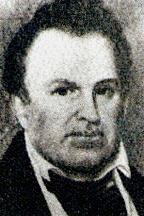
Summary
William W. Irvin (April 5, 1779 [1] – March 27, 1842) also spelled Irwin[2] was a lawyer, farmer, politician, and two-term U.S. Representative from Ohio from 1829 to 1833.
William Irvin | |
|---|---|
 | |
| Member of the U.S. House of Representatives from Ohio's 9th district | |
| In office March 4, 1829 – March 3, 1833 | |
| Preceded by | Philemon Beecher |
| Succeeded by | John Chaney |
| Associate Justice of the Ohio Supreme Court | |
| In office April 2, 1810 – February 16, 1816 | |
| Preceded by | William Sprigg |
| Succeeded by | Jessup Nash Couch |
| Member of the Ohio House of Representatives | |
| In office 1806–1807 | |
| Personal details | |
| Born | April 5, 1779 Charlottesville, Virginia, U.S. |
| Died | March 27, 1842 (aged 62) Lancaster, Ohio, U.S. |
| Political party | Jacksonian |
| Spouse | Elizabeth Gillespie |
| Children | 7 |
Biography edit
Born near Charlottesville, Virginia, Irvin pursued an academic course and later studied law. He was admitted to the bar in 1800 and commenced practice in his native county. He moved to Lancaster, Ohio, about 1801 and continued the practice of his profession.
He was appointed by an April 9, 1803 joint session of the Ohio Senate and Ohio House to serve as an associate judge of the court of common pleas for Fairfield County by the first general assembly. He was impeached in on February 22, 1805 by the Ohio House of Representatives. His impeachment trial before the Ohio Senate began on December 9, 1805, and he was convicted and removed from by an 11–4 vote on January 11, 1806.[3][4]
Irvin served as member of the Ohio House of Representatives in 1806 and 1807, and was a justice of the Supreme Court of Ohio from 1810 to 1815. He finished third in election for Governor of Ohio in 1822.[2] He was again a member of the Ohio House of Representatives 1825-27 and served as speaker in 1825 and 1826. He came in third for election to the United States Senate in 1827, losing to Benjamin Ruggles. [5]
Irvin was elected as a Jacksonian to the Twenty-first and Twenty-second Congresses (March 4, 1829 – March 3, 1833). He was an unsuccessful candidate for reelection in 1832 to the Twenty-third Congress.
He returned to his farm near Lancaster and engaged in agricultural pursuits until his death on March 27, 1842.
Irvin was married to Elizabeth B. Gillespie in Lancaster on February 2, 1813. They had seven children.[2]
Notes edit
- ^ William W. Irvin at Find a Grave
- ^ a b c "William W. Irvin". The Supreme Court of Ohio and the Ohio Judicial System. Retrieved April 10, 2012.
- ^ Utter, William T. (1927). "Judicial Review in Early Ohio". The Mississippi Valley Historical Review. 14 (1): 3–24. doi:10.2307/1892041. ISSN 0161-391X. JSTOR 1892041. Retrieved December 26, 2022.
- ^ "William W. Irwin » Supreme Court of Ohio". www.supremecourt.ohio.gov. Supreme Court of Ohio. Retrieved December 26, 2022.
- ^ Taylor 1899 : 129
Sources edit
- United States Congress. "William W. Irvin (id: I000034)". Biographical Directory of the United States Congress.
- Taylor, William Alexander; Taylor, Aubrey Clarence (1899). Ohio statesmen and annals of progress: from the year 1788 to the year 1900 ... State of Ohio. p. 129.
External links edit
This article incorporates public domain material from the Biographical Directory of the United States Congress


